The Israel Defense Forces (IDF) continued to conduct an operation in and around al Shifa Hospital in Gaza City on March 22.[i] The IDF 401st and Nahal Brigades (162nd Division) and Israeli special operations forces have killed approximately 150 Palestinian fighters in the hospital area since the operation began on March 18.[ii] Palestinian militias focused their attacks in the Gaza Strip on March 22 on Israeli forces al Shifa Hospital.[iii] A Palestinian journalist reported that Israeli forces ”intensified” operations in Gaza City east of al Shifa Hospital.[iv] Hamas’ infiltration into the al Shifa Hospital area after Israel’s initial clearing operation highlights Hamas’ efforts and determination to reestablish itself in the northern Gaza Strip.[v]
Palestinian fighters may be retreating from certain areas of the Gaza Strip during Israeli clearing operations there before reentering those areas after the Israelis depart. Israeli forces are not permanently securing the areas that they clear, which allows Palestinian fighters to return after the IDF leaves. The current clearing operation in and around al Shifa Hospital is the third clearing operation in southern or western Gaza City. Israeli forces have launched new clearing operations in several neighborhoods surrounding al Shifa Hospital three times—including the ongoing operation—since January. Israeli forces re-cleared al Shati Camp—to the immediate north of al Shifa Hospital—and Rimal neighborhood—where al Shifa Hospital is located—in early February and Zaytoun neighborhood, southeast of Rimal, in late February.[vi] Palestinian militias may have temporarily retreated from these areas during the Israeli operations there, as demonstrated by the large number of fighters that Israeli forces have detained during the newest Israeli clearing operation in Rimal focused on al Shifa Hospital, which began on March 18.
Palestinian militias may be maintaining at least one VBIED cell near Tubas. Hamas fighters detonated a vehicle-borne improvised explosive device (VBIED) targeting an IDF bulldozer in Tubas during an Israeli raid on March 21.[vii] Palestinian fighters have deployed at least three VBIEDs targeting Israeli forces in the northern West Bank in 2024, including two VBIEDs in Tubas since March 7.[viii] CTP-ISW previously noted on March 7 that the two VBIED attacks on and prior to March 7 suggested the existence of a VBIED cell in the northern West Bank.[ix] It is unclear how sophisticated or well-manufactured these VBIEDs are. VBIEDs require significant logistical infrastructure, including dedicated workshops to reassemble cars after technicians take apart the vehicles and pack them with explosives.[x] VBIEDs also require bombmaking facilities, an area to stash the VBIED prior to its deployment, and a security detachment for the workshop and bombmaking facilities. The Palestinian militias in Tubas may be collaborating to assemble and deploy these VBIEDs, given the level of resources and expertise required.
A Hamas sniper wounded seven Israelis near an Israeli settlement in the West Bank on March 22 in a multi-stage ambush.[xi] The sniper fired multiple rounds at an Israeli bus near Dolev before engaging the IDF quick reaction force that responded to the attack.[xii] The sniper fired at the IDF quick reaction force from a series of pre-prepared firing positions for several hours before an IDF helicopter killed him.[xiii] The al Aqsa Martyrs‘ Brigades, Palestinian Mujahideen Movement, and Popular Front for the Liberation of Palestine all praised the sniper attack.[xiv]
The pause in Iranian-backed Iraqi militia attacks does not indicate a change in the long-term Iranian and Iranian-backed proxy objective to expel the United States from the Middle East. The Islamic Resistance in Iraq–an umbrella group of Iranian-backed Iraqi militias–has not conducted attacks targeting US forces in Iraq or Syria for 47 days.[xv] IRGC Quds Force Commander Esmail Ghaani ordered the Islamic Resistance in Iraq to pause attacks targeting US forces in Iraq and Syria following the January 28 attack that killed three US service members in northeast Jordan.[xvi] Iranian-backed Iraqi militias retain the capability to resume attacks targeting US forces at any time for any reason of their choosing. CENTCOM Commander General Michael Kurilla said during a Senate Armed Service Committee Hearing on March 7 that Iran has continued to send arms and funding to its Iraqi militias during the pause in attacks.[xvii] Iran and its so-called ”Axis of Resistance“ in Iraq have not deviated from their objective to remove US forces from Iraq. Kataib Hezbollah Secretary General Abu Hussein al Hamidawi met with unspecified leaders in Iran‘s ”Axis of Resistance” in Tehran on March 20 and said that the current pause in attacks on US forces does not mark the end of efforts to expel US forces from Iraq.[xviii]
Key Takeaways:
- Gaza Strip: The IDF continued to conduct an operation in and around al Shifa Hospital in Gaza City. Palestinian fighters may be retreating from certain areas of the Gaza Strip during Israeli clearing operations there before reentering those areas after the Israelis depart.
- West Bank: Palestinian militias may be maintaining at least one VBIED cell near Tubas.
- Iraq: The pause in Iranian-backed Iraqi militia attacks does not indicate a change in the long-term Iranian and Iranian-backed proxy objective to expel the United States from the Middle East.
- Yemen: US CENTCOM and the French Navy intercepted multiple Houthi ballistic missiles and a Houthi naval attack drone in the Red Sea in several separate incidents.
- Iran: Iranian Foreign Affairs Minister Hossein Amir Abdollahian discussed the Israel-Hamas war in separate phone calls with Hamas Political Bureau Chairman Ismail Haniyeh and PIJ Secretary General Ziyad al Nakhalah.
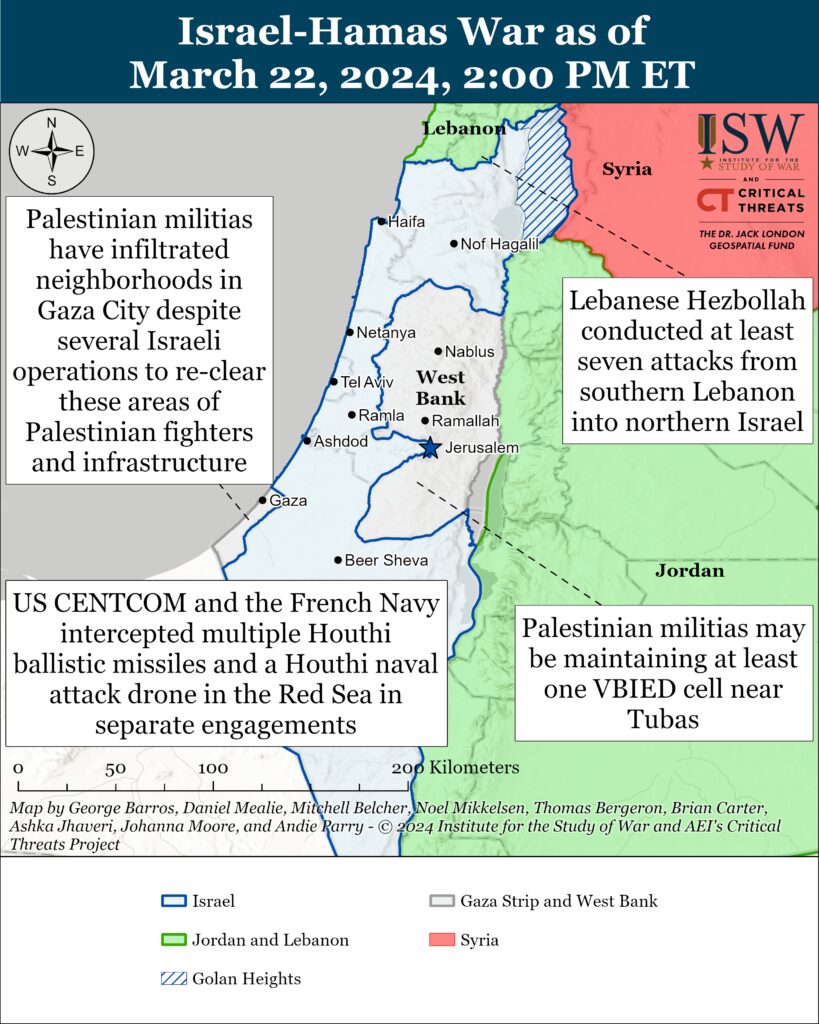
Gaza Strip
Axis of Resistance campaign objectives:
Erode the will of the Israeli political establishment and public to launch and sustain a major ground operation into the Gaza Strip
Degrade IDF material and morale around the Gaza Strip.The IDF Nahal Brigade (162nd Division) continued clearing operation in the central Gaza Strip on March 22.[xix] The IDF reported that unspecified Palestinian fighters launched mortars targeting Israeli forces in the central Gaza Strip and Israeli forces responded with artillery fire.[xx]
Israeli forces continued clearing operations in Qarara, northern Khan Younis, on March 22. The IDF Air Force struck tunnel shafts and two structures in Qarara that Palestinian fighters had rigged to explode.[xxi]
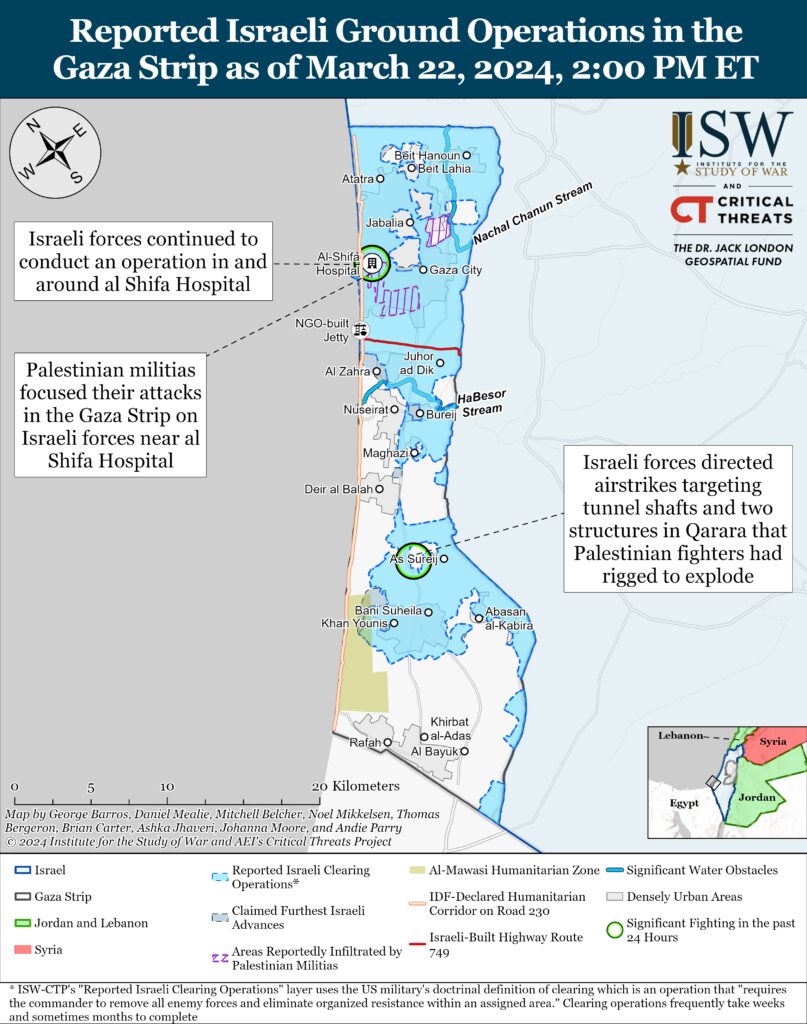
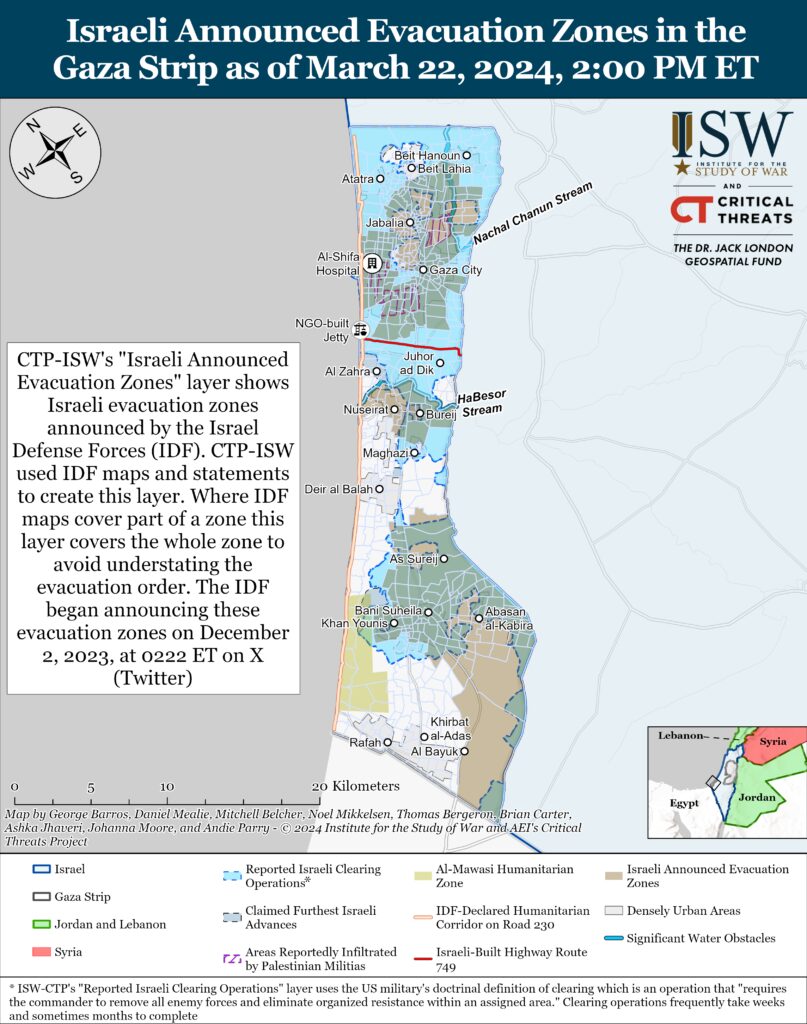
US Secretary of State Antony Blinken met with Israeli Prime Minister Bejamin Netanyahu and the Israeli War Cabinet in Tel Aviv on March 22.[xxii] Blinken discussed efforts to reach a six-week ceasefire to secure hostages and enable a surge in humanitarian aid. Blinken also briefed the Israeli War Cabinet about efforts he made during his visits to Jeddah, Saudi Arabia, and Cairo, Egypt, to “achieve lasting peace.” Netanyahu said at the end of his meeting with Blinken that there is “no way to defeat Hamas without entering Rafah” and that Israel will “do it alone” if it must.[xxiii]
Two unspecified US officials told CNN on March 21 that Blinken told Qatar that Hamas must agree to a ceasefire deal or risk getting kicked out of Doha.[xxiv] Several senior Hamas members, including Hamas Political Bureau Chairman Ismail Haniyeh, are based in Doha. CNN noted that Blinken made the comment on March 5 at a time when negotiations between Hamas and Israel had stalled. The officials said that Qatar understood the message and “received it without major pushback.”
The Israeli Prime Minister’s Office confirmed that CIA Director Bill Burns will travel to Doha on March 22 to join ceasefire negotiations.[xxv] The talks also include Israeli and Egyptian intelligence chiefs and the Qatari prime minister. Israel and Hamas began a new round of negotiations on March 18.[xxvi]
Several Arab and Israeli sources told the Wall Street Journal on March 22 that Israel is developing a plan to distribute aid in the Gaza Strip that “could eventually create a Palestinian-led governing authority” to contest Hamas.[xxvii] The Israeli plan involves distributing the aid via Palestinian leaders and businessmen without links to Hamas who would be recruited by Israel. An Israeli official noted that Hamas’ “vehement opposition” could make the plan unfeasible. Some of this ”vehement opposition” may include Hamas-ordered assassinations targeting Gazan notables. Hamas reportedly killed the head of a large local clan on March 13. Palestinian civilians accused the clan of cooperating with Israel.[xxviii] The Israeli official noted that Hamas can reassert itself due to the governance vacuum that exists in the Gaza Strip. Hamas has already sought to reconstitute militarily and rebuild its governing authority in the northern Gaza Strip after the Israeli drawdown in the Strip that began in December 2023.
Israeli officials are currently debating the issue of humanitarian aid distribution in the Gaza Strip. Israeli media reported on March 8 that Israeli officials have discussed arming civilians in the Gaza Strip to provide security for aid convoys.[xxix] Israeli Defense Minister Yoav Gallant has proposed involving Fatah in the distribution. Netanyahu has shut down proposals for aid distribution involving the Palestinian Authority.[xxx] Israeli officials have also not yet identified an actor or organization that could lead Gaza in the future, though some Israeli officials have proposed working with local clans.[xxxi] Hamas reportedly killed the head of a local clan in Gaza City on March 13 amid local accusations that the clan was cooperating with Israel.[xxxii] The heads of Palestinian tribes, clans, and families in the Gaza Strip affirmed on March 19 that they are not an alternative to any Palestinian political solution. They added that they denounced Israel, calling Israel an occupier.[xxxiii]
Palestinian militias did not conduct indirect fire attacks from the Gaza Strip into Israel on March 22. The IDF reported on March 22 that it intercepted a rocket that Palestinian fighters launched on March 21 from the central Gaza Strip into southern Israel.[xxxiv] The Palestinian Islamic Jihad and Popular Front for the Liberation of Palestine claimed the March 21 attack.[xxxv] The IDF Air Force conducted airstrikes targeting military infrastructure in the Strip in response to the attack. [xxxvi]
West Bank
Axis of Resistance campaign objectives:
Draw IDF assets and resources toward the West Bank and fix them thereIsraeli forces have clashed with Palestinian fighters in at least six locations in the West Bank since CTP-ISW’s last data cutoff on March 21.[xxxvii] The al Aqsa Martyrs’ Brigades, Hamas, and PIJ separately claimed that they detonated improvised explosive devices (IED) and fired small arms targeting Israeli forces operating in Tubas on March 21 and 22 (see topline for analysis of a VBIED detonation in Tubas during the raid).[xxxviii] The al Aqsa Martyrs’ Brigades also engaged Israeli forces in Qalqilya and near Nablus.[xxxix] The group threw an IED targeting a civilian bus near Bethlehem and fired small arms at an Israeli settlement near Jenin.[xl]
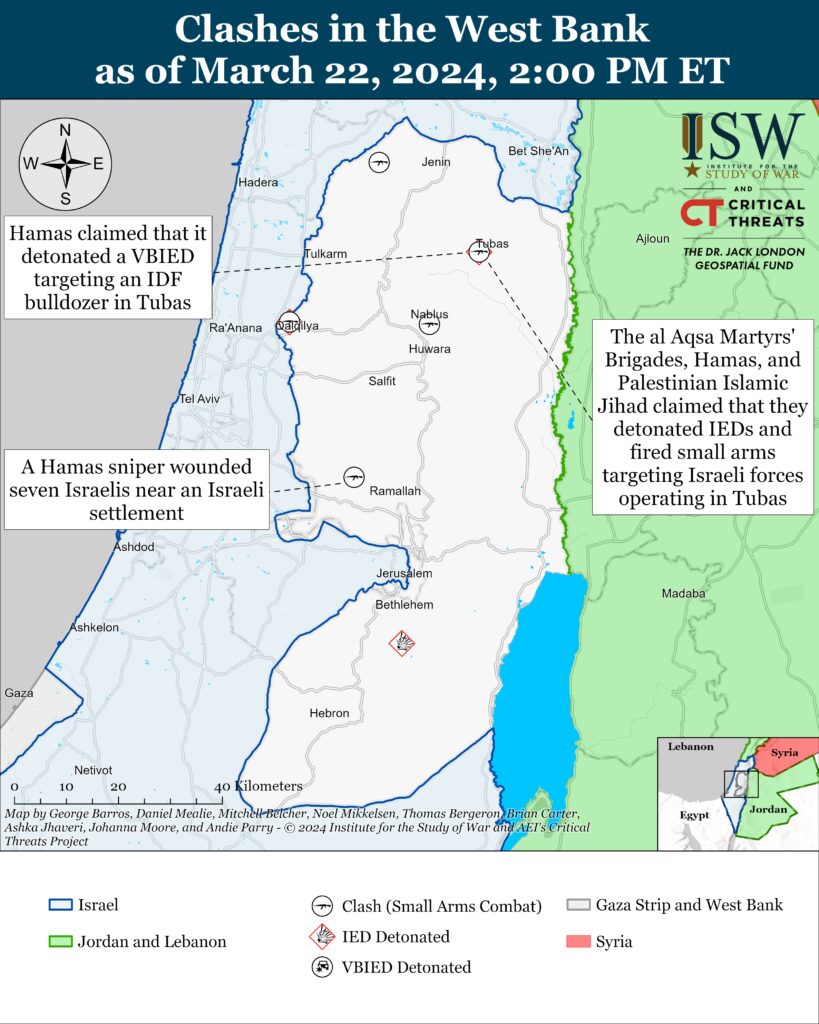
This map is not an exhaustive depiction of clashes and demonstrations in the West Bank.
Southern Lebanon and Golan Heights
Axis of Resistance campaign objectives:
Draw IDF assets and resources toward northern Israel and fix them there
Set conditions for successive campaigns into northern IsraelLebanese Hezbollah has conducted at least seven attacks from southern Lebanon into northern Israel since CTP-ISW’s last data cutoff on March 21.[xli]

Recorded reports of attacks; CTP-ISW cannot independently verify impact.
Iran and Axis of Resistance
Axis of Resistance campaign objectives:
Demonstrate the capability and willingness of Iran and the Axis of Resistance to escalate against the United States and Israel on multiple fronts
Set conditions to fight a regional war on multiple frontsUS CENTCOM and the French Navy intercepted multiple Houthi ballistic missiles and a Houthi naval attack drone in the Red Sea on March 21 in several separate incidents.[xlii] US CENTCOM intercepted a Houthi naval attack drone in the Red Sea on March 21.[xliii] CENTCOM also reported that coalition forces intercepted two Houthi ballistic missiles in the Red Sea. A French frigate also intercepted three additional Houthi ballistic missiles over the southern Red Sea.[xliv]
Houthi-controlled media claimed on March 22 that the United States conducted airstrikes targeting Houthi-controlled Yemeni territory.[xlv] The outlet said that the strikes targeted al Kadan, Hudaydah Governorate, western Yemen.
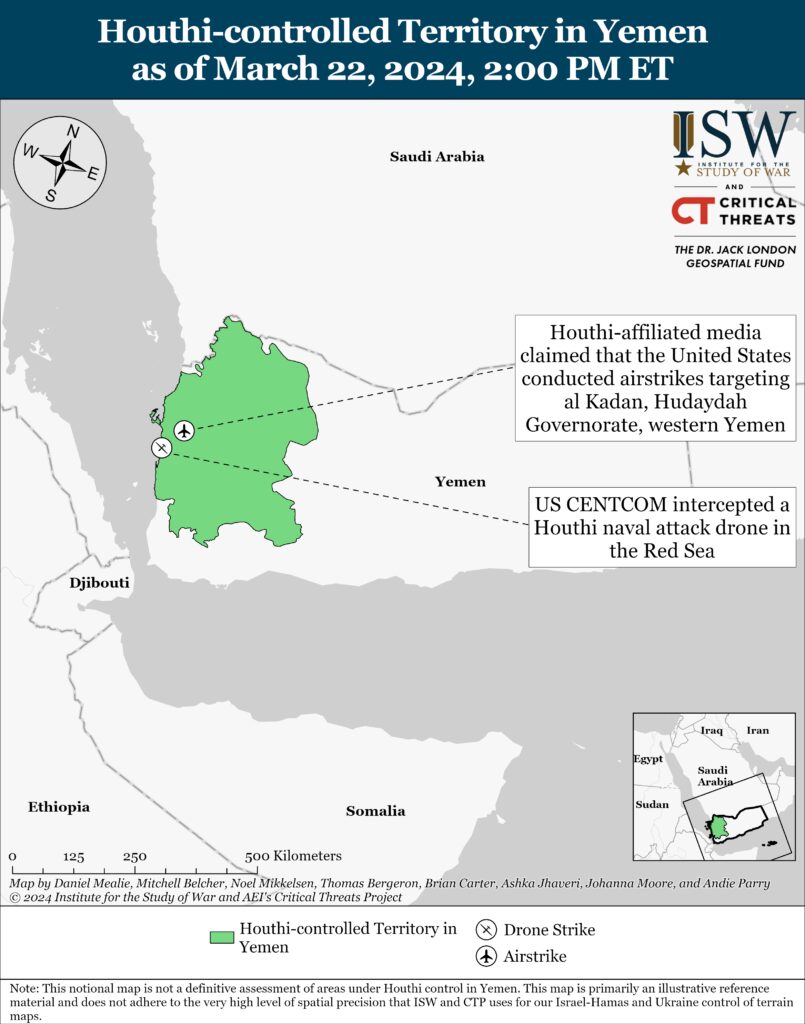
Iranian Foreign Affairs Minister Hossein Amir Abdollahian discussed the Israel-Hamas war in separate phone calls with Hamas Political Bureau Chairman Ismail Haniyeh and PIJ Secretary General Ziyad al Nakhalah on March 21 and 22, respectively. [xlvi] This marks Abdollahian and Haniyeh’s fifth phone call since October 7.[xlvii] Abdollahian last met with Nakhalah in February 2024 during a meeting with leaders of various Palestinian factions in Beirut.[xlviii]
Tehran Interim Friday Prayer Leader Mohammad Javad Haj Ali Akbari said during Friday prayers on March 22 that Israel must be prepared for a “second, third, and fourth” October 7-style attack.[xlix] Akbari stated that Muslim countries must prepare for a ”different” Quds Day this year by creating a ”political earthquake” for Israel and its supporters. Quds Day is an anti-Israel holiday started by Iran and will occur on the last Friday of Ramadan, April 5, 2024.[l]
Akbari’s statement reflects the thinking of Iranian leaders on how to defeat Israel. IRGC Commander Maj. Gen. Hossein Salami said in 2022 that Palestinian militias needed to focus on successive offensive ground operations into Israel instead of defensive, static wars using their rocket systems.[li] Iran’s leaders theorize that these ground operations will result in mass Israeli emigration and the collapse of the Israeli state. Hamas Political Bureau member Ghazi Hamed seemingly echoed these sentiments in a television interview on November 1, when he said that Hamas would repeat the October 7 attacks “a second, a third, [and] a fourth” time.[lii]
 Eurasia Press & News
Eurasia Press & News


